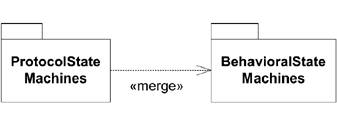Section 3.4. Merging Packages
3.4. Merging PackagesUML supports a somewhat complex concept of merging packages. Merging packages differs from importing packages in that merge, by definition, creates relationships between classes of the same name. The motivation behind package merging comes directly from the evolution of UML from 1.x to 2.0. UML 2.0 defines the base concept of elements and allows specific diagram types to extend a base concept without needing to provide a new name for it. For example, UML extends several core Behavioral State Machine concepts into Protocol State Machine concepts while retaining their original name. When a package merges another package, any class of the same type and name automatically extends (or has a generalization relationship to) the original class. For example, UML can define the concept of the include relationship at a generic level and then specialize it for use cases inclusion and retain the name include. This type of extension has simplified the internals of the UML model but rarely makes an appearance in real-world development. You show package merging using a dashed line with an open arrow from the merging package to the merged package. Label this line with the keyword «merge». Figure 3-7 shows an example of merging two packages. Figure 3-7. ProtocolStateMachines merging the elements from BehavioralStateMachines so it can add to the contained classes The rules for package merge are:
|
EAN: 2147483647
Pages: 132